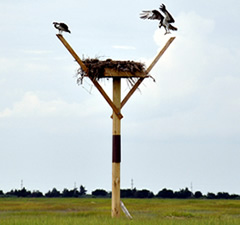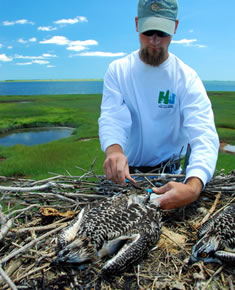  |
Osprey Nest Structure Placement |
|
Placement of nest structures for ospreys affects the chances they'll be used. As a general rule, the
closer to water, the better. Colonization of new sites is related to how close ospreys presently nest
to the new site, since young birds returning to breed usually take up nesting within one to several
miles of their natal area.
|
Another important consideration is predation. We recommend single pole structures with a platform on top, on mainland areas and any area where raccoons and other predators are present. Single poles are easily outfitted with a predator guard (inverted cone, or a sleeve of aluminum flashing) that prevent raccoons from climbing into the nest. A raccoon has been seen climbing into a 30-foot high nest, so a guard is very necessary on most nests.
An attractive nest, to an Osprey, includes a nearby perch. The male prefers to perch either on the
nest or within 20-40 feet. A 2x4 that rises two to three feet higher on both sides of the nest
platform is ideal, as is a perch pole of at least 4 feet in height, placed nearby. A simple perch
consists of a 2x4 with a wood branch (~11/2 to 2” in diameter) mounted perpendicularly on top of
the 2x4.
|

A pair of ospreys occupies a nesting platform on Great Bay in Little Egg Harbor.
Photo by Bill Steiner
Click to enlarge
|
Ospreys generally return to New Jersey in late March and take up nesting in April. Nest structures
should be in place by mid-March for that season's use. Ospreys are most sensitive to disturbance during April, when they are laying eggs, and are most likely to abandon the nest if disturbance is too great. They will grow more defensive of the nest area in May and June when they have chicks, and both male and female must feed intensively to keep up with all the appetites. It is important that disturbance remain low during this time as well.

Ben Wurst bands a nestling while conducting a ground survey to help monitor
the state population.
Photo by Jonathan Carlucci
Click to enlarge
|
Ospreys have exhibited tolerance of certain types of disturbance, such as boat traffic on waterways, as long as such traffic ignores them. Disturbance increases as boats stop nearby and people focus on the birds at close range. A safe distance from which to observe ospreys will vary depending on the area, but observers must stay beyond the distance at which the adults react. Their reaction must be judged as even their attention to the observer, not simply when they lift off the nest in defense.
If you put up an osprey nest structure, please send GPS coordinates, or map in Google Earth or
online, and e-mail the Conserve Wildlife Foundation of NJ the location. We include all potential nest sites in our triennial survey of ospreys in the state. If the nest is used by ospreys, please notify us.
Finally, we offer technical assistance to private consulting firms, individuals, school groups,
environmental commissions, Boy & Girl Scouts, and anyone else who is interested in building
and constructing osprey nesting structures. We can help you choose the most suitable location to
place a platform so it will not negatively impact any other wildlife that may live in the area.
Please do not hesitate to contact us for more information or if you have a question.
|
For further information, please contact Kathy Clark, Supervising Zoologist, NJ Division of Fish and Wildlife, or Ben Wurst, Habitat Program Manager, Conserve Wildlife Foundation of NJ, at 609-628-2103.
Living With Osprey: A guide for the removal, relocation, and placement of osprey nests (pdf, 800kb)
Osprey Nest Platform Plans and Placement Information (pdf, 930kb)
Conserve Wildlife Foundation's Osprey Project - Learn more about platform construction and placement.
Guidelines for Maintenance at Communication Towers that Support Raptor Nests (pdf, 45kb)
|


